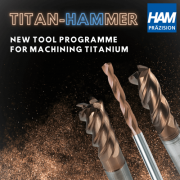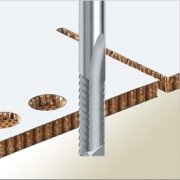When titanium meets Swabian know-how: titanium machining live at our workshop!

Titanium – a material that is increasingly playing a key role in the modern manufacturing environment. However, due to its strength and material properties, machining it is demanding and requires specialized strategies. So how exactly can these challenges in titanium machining be mastered?
It was precisely these complex requirements that we examined in depth during our workshop. After all, a material of extremes requires equally extreme solutions. Advanced CNC technologies and special tools are required for machining. And this is exactly where our new HAM titanium program comes into play. In combination with modern cooling methods, it enables efficient and precise machining of titanium, which was impressively demonstrated during live machining.
Titanium: An overview of the light metal and its grades
Titanium, a light and resistant element, is highly sought after due to its low density and high resistance to corrosion and heat. Although the light metal is one of the ten most common elements in the earth’s crust, it is mainly found in minerals, which makes its extraction considerably energy-intensive – around four times as much as aluminum.
But not all titanium is the same! It is divided into different categories, known as “grades”, which represent either pure or alloyed titanium. Pure titanium is found in grades 1 to 4, with grade 2 being the most commonly used in medical technology with 99.7% pure titanium. It offers a good balance between strength and malleability. Alloyed titanium, on the other hand, ranges from grade 5 to 39, with grade 5 (Ti-6Al-4V) being one of the most commonly used titanium alloys in the aerospace industry, containing aluminum and vanadium and offering high strength and corrosion resistance.
The choice of grade depends on the requirements for strength, weight and corrosion resistance. Titanium outperforms aluminum, CFRP and GFRP in terms of tensile strength, but lags behind steel. However, no general statement can be made about density. Depending on the type of aluminum, the density is very close to that of titanium. However, the density of CFRP with a volume of 50% exceeds both titanium and aluminum.
The challenges of titanium machining and possible solutions
The processing of titanium poses considerable challenges for machining companies. High strength and toughness lead to higher cutting forces and temperatures and therefore to increased tool wear. The problem is exacerbated by the low thermal conductivity of titanium, as the heat generated is not effectively dissipated into the chip, but mainly into the tool. While around 80 % of the heat from steel is dissipated into the chip, only 20 % dissipates into the chip in titanium. In addition to this is the strong reactivity with oxygen, which causes increased tool wear due to diffusion at high temperatures. Heat and friction are therefore the main challenges when machining titanium.
But how can these challenges be overcome? One of the most effective ways to minimize heat and tool wear is to avoid high cutting speeds. Special solid carbide tools with sharp cutting edges ensure clean cutting and prevent breakage. Uneven tool spacing helps to minimize vibration and extend tool life by promoting even wear of the cutting edges. It also ensures better chip removal and optimized cutting forces. The correct coordination of carbide substrate and coating optimizes the heat resistance and sliding properties of the tool. The use of special coolants and optimum internal cooling of the tools are also crucial for improving process stability

Our solution: The new HAM titanium program
Our HAM standard tools are optimized for “wet” use and benefit from a flow-optimized design, which is achieved by the larger MQL shaft chamfer and a round MQL cooling channel connection. Reduced guide chamfers help to lower the temperature, while an increased taper minimizes friction as less cutting surface “rubs” against the workpiece. This is complemented by our innovative HSF (Hybrid Surface Finish) surface technology, which guarantees a smooth surface and thus further reduces friction during titanium machining.
40-3011: Our 5-cutter for trochoidal milling
The HAM 40-3011 offers maximum efficiency thanks to an internal cooling and a special coating that makes it particularly suitable for titanium machining. It has 5 teeth and is available in diameters from 6 to 20 mm.

iMachining Ø 20 | allowance 0.2mm | emulsion | roughing / finishing machining parameters
- ap / ae = 38 / 0,18-0,81 | 38 / 0,2
- n = 2.045 rpm | 1.115 rpm
- Vc = 180 m/min | 70 m/min
- fz = 0,24 mm/z | 0,06 mm/z
- Vf = 2.410 mm/min | 360 mm/min
iMachining Ø 12 | allowance 0.2mm | emulsion | roughing machining parameters
- ap / ae = 23 / 0,11-0,48
- n = 3.200 rpm
- Vc = 122 m/min
- fz = 0,12 mm/z
- Vf = 1.910 mm/min
40-3001: Our 3-cutter for full-slot milling up to 1.5xD
Our HAM 40-3001 is characterized by an internal cooling, 3 teeth and diameters from 6 to 20 mm. Thanks to a special coating, it is ideal for machining titanium and offers high wear resistance in demanding applications.

Slot 1xD Ø 10 | allowance 0.00 mm | MQL | roughing / finishing machining parameters
- ap / ae = 10 / 10 | 10 / 0,2
- n = 1.600 rpm | 2.550 rpm
- Vc = 50 m/min | 80 m/min
- fz = 0,05 mm/z | 0,08 mm/z
- Vf = 240 mm/min | 610 mm/min
Slot1.5xD Ø 10 | allowance 0.00 mm | MQL | roughing / finishing machining parameters
- ap / ae = 15 / 10 | 15 / 0,1
- n = 1.600 rpm | 2.550 rpm
- Vc = 50 m/min | 80 m/min
- fz = 0,025 mm/z | 0,08 mm/z
- Vf = 120 mm/min | 610 mm/min
HAM Titandrill: Our process-reliable 3xD deep hole drill with internal cooling
This tool combines a 30° helix angle with 2 teeth for high performance. Available in 3xD and 5xD, it is equipped with a special chip chamber geometry to ensure improved chip evacuation.

Core hole Ø 6.8 | allowance 0.00 mm | MQL | roughing / finishing machining parameters
- ap = 20
- n = 1.640 rpm
- Vc = 36 m/min
- f = 0,05 mm/U
- Vf = 164 mm/min
Core hole Friction Ø 7.8 | allowance 0.00 mm | MQL | roughing / finishing machining parameters
- ap = 20
- n = 1.500 rpm
- Vc = 36 m/min
- f = 0,05 mm/U
- Vf = 150 mm/min
Advantages of our HAM titanium program
Our innovative tool geometries with central internal cooling ensure maximum performance and efficient heat dissipation in order to achieve maximum efficiency even in demanding machining processes. Thanks to the smooth running and low-vibration machining, precise and reliable machining is achieved, which significantly improves the machining quality. With our newly developed wear protection coating for titanium and the unique Hybrid Surface Finish (HSF), not only is a defined preparation of the cutting edge achieved, but also an extremely smooth surface. The heat-resistant surface coating can withstand temperatures up to over 1000 °C. It can also be used in MQL processes (minimum quantity lubrication) under certain conditions, which further increases sustainability and process reliability.

Looking to the future of titanium in modern manufacturing
The properties of titanium – high strength, low weight and excellent corrosion resistance – make it one of the most sought-after materials in manufacturing. The aviation, automotive and medical technology industries have long recognized the potential of titanium. However, the high cost of machining has so far prevented titanium from being widely used in mass production. But with advanced machining techniques and the right choice of tooling, these hurdles could soon be overcome. It is therefore no wonder that experts expect the overall share of titanium alloys to grow by 20 percent over the next few years. Industries such as aerospace, e-mobility and electronics show strong growth potential for the use of titanium. With more efficient machining techniques and a targeted production strategy, titanium could eventually replace stainless steel and aluminum in many applications and usher in a new era in manufacturing.


 HAM GmbH
HAM GmbH


